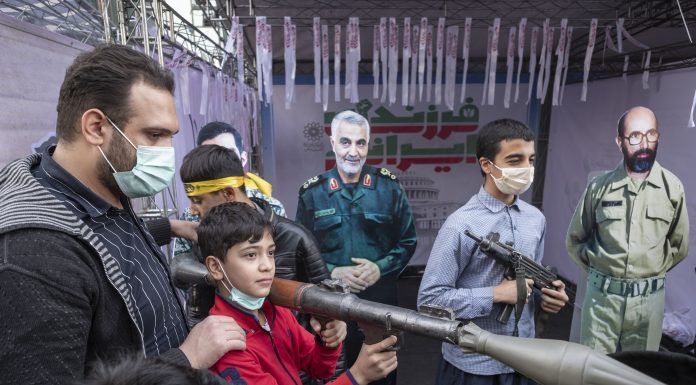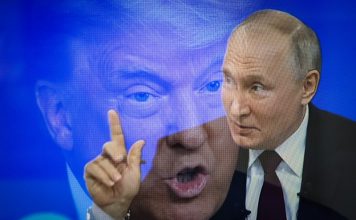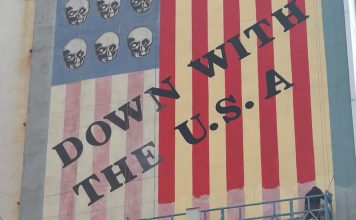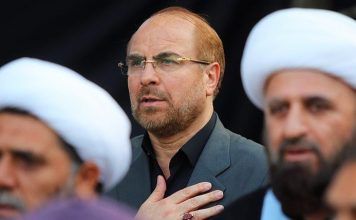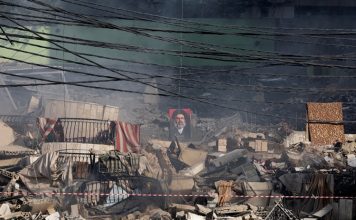By Simorgh (Iran)
The recent publication of photographs of underage children in riot police uniforms carrying compliance tools has raised eyebrows and sparked public outrage.
However, a closer examination of the photographs shows that the small shields and batons are more like toys than standard-issue riot police gear.
Children must be protected against possible violence in street protests and not exposed to any danger. It is not clear why these underage children are photographed wearing full riot police gear.
The answer lies in the composition of the Islamic Revolutionary Guards Corps (IRGC), Basij (volunteer militias), riot police, and other security forces — and the degree of their loyalty to the state.
We can divide ideological forces loyal to the state into three groups: anti-riot units, forces hostile to the U.S. and Israel, and revolutionary ideologues.
Anti-riot units adhere to medieval beliefs and follow orders blindly. They even attack and brutalize fellow Iranian citizens to ensure the survival of the Islamic Republic. Although small, the group has the complete trust of the state.
The ideological forces which fight to the death for their anti-Israel and anti-U.S. sentiments might hesitate to brutalize their compatriots and could even revolt against the regime. As a result, they do not have the state’s trust, which does not deploy them to crack down on protesters.
There are also the original revolutionary ideologues who are old and cannot fight against the younger generations, which includes their children and grandchildren.
Conscripts form a large segment of forces in military marches and army bases. Most enlisted soldiers come from average Iranian families horrified by the brutal treatment of Iranian citizens.
They might join protesters and even fight security forces if they had weapons. The state does not trust this group and never uses them to crack down on protesters.
Most IRGC and security forces personnel have no strong ideological beliefs nor are they loyal to the state. Most of them have sought employment with these institutions for other reasons than religion or politics. For them, being part of the IRGC or security forces is just a job and a source of income.
Most people in this group have secured their jobs through influential contacts and would have gladly accepted any position available in any state organ. They are ordinary Iranians whose main concern is to provide for their families. They do not have blind loyalty to the state.
Authorities are acutely aware of this and know that this group would join forces with the people against a weakened regime. As a result, the state does not trust this group and never uses them to crack down on protesters.
Most Iranians believe the Basij forces are staunch supporters of the regime and are prepared to die defending the Islamic Republic establishment.
However, this is not true. While a small segment of the Basij is a diehard supporter of the Islamic Republic regime, the majority are young opportunists using the group to fulfill their ambitions.
Some students join the force to receive Basij allowances and get admitted to better universities. Others hope to receive a special “order” by joining the Basij, which could shorten the length of their compulsory military service or allow them to complete it in a government office instead of a military base.
Some government employees signed up with the Basij during its enrolment period, fearing they could lose their jobs if they did not join the group. Others join to take advantage of benefits and privileges given to Basij members.
Some young Iranians join the Basij to pull themselves out of poverty and provide for their families. Their main priority is not to defend the Islamic Republic regime but to have a career and financial security.
The state uses a select group of plainclothes Basij for security and crowd control.
Although the Islamic Republic establishment hails the Basij as a loyal force, it knows that most members of the group struggle with financial issues and are not diehard supporters of the regime. As a result, the state does not trust a large segment of the Basij units and cannot use them to crush any unrest.
Many in the government or the Iranian military participate in state-sponsored marches, seeking to enrich themselves and climb the social ladder quickly. Most of them are after easy money. They publicly profess their loyalty to the ruling regime but privately join people in criticizing the state. Many of their children live comfortable lives in Europe.
These opportunists only look after their interests and never risk their lives protecting the regime. As a result, the state does not trust this group and never uses them to crack down on protesters.
The ongoing national protests sparked by the death of the 22-year-old Mahsa (Zhina) Amini while in the custody of the morality police on Sep.16 have pressured the state security apparatus. As a result, there is a shortage of forces loyal to the Islamic Republic regime in Iran.
Footage of recent nationwide protests shows that the state has been deploying a few riot police, Basij units, and security forces to control crowds. In some video clips, only dozens of riot police and plainclothes security units are seen confronting a large crowd.
Fearing some members of riot police, Basij units, and security forces may join protesters, the state has not supplied uniforms and ammunition to many soldiers and IRGC and security forces personnel. It has also limited the number of forces sent to the streets.
The state has resorted to methods used in ancient wars to compensate for the shortage of its forces. In ancient times, armies would increase the number of flags hoisted on poles or spears during wars to exaggerate the number of troops.
They would also try to instil fear in the hearts of the enemy soldiers by beating drums that could be heard miles away. They would also put ominous masks on their horses to generate fear.
The Islamic Republic uses similar tactics. Recent attempts to put underage children in riot police uniforms and gear could be seen as an attempt to compensate for the small number of diehard forces loyal to the regime.
The regime is not worried that these children might join protesters. It only wants to increase the number of its forces in the streets because protesters cannot tell the age of these children from a distance.
The state has also used black motorcycles, water cannons, and other tools to scare off protesters. Seeing two water cannons, 20 motorcycles, 20 shields, 20 riot police, and dozens of children in riot gear positioned at an intersection could be extremely intimidating, even though there are only 20 riot police against 1,000 protesters.

